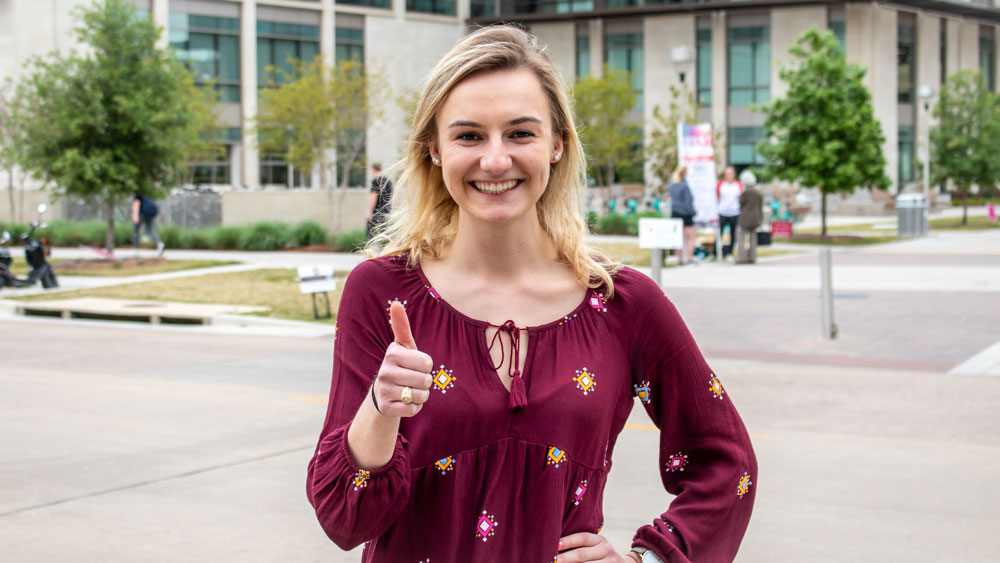
For senior Clare Lamers, the Texas A&M University experience has been all about taking steps in the right direction.
As a student ambassador for the Department of Electrical and Computer Engineering, she has helped prospective students take their first steps toward higher education and has taken her own steps to improve her communication and leadership skills.
Now, as she prepares to step across the graduation stage and into her new position in product test validation for Texas Instruments, she took a moment to look back at her academic journey.
“When I first came to Texas A&M as a freshman, I really had no idea what I was doing. I was always interested in radiology and biomedical imaging, so I was originally considering going into nuclear engineering or radiological health,” said Lamers. “But then I went to a presentation at my New Student Conference about electrical engineering and found out that they have all these different specializations, including biomedical imaging, and that was really attractive to me.”
As an ambassador, her relatable experience and love for Texas A&M has helped Lamers connect with prospective and current students alike. Whether she is presenting to a visiting family about the electrical and computer engineering department or aiding academic advisors to field questions during high traffic times throughout the semester, Lamers is happy to take the lead, chat and help in any way that she can.
Above all else, Lamers said that her favorite part of being an ambassador is talking to people. With prior experience in speaking with high school and middle school students, she works with various campus organizations on outreach to that age group and shares her experiences and stories about Texas A&M. In doing so, she also takes the time to explain what electrical engineering is and what the department has to offer.
The invaluable communication and leadership skills that Lamers honed as an ambassador have also bolstered her and helped her succeed in the Undergraduate Research Scholars program, where she took steps to shed light on potential blackout situations then had to present her research to an audience of technical and nontechnical judges.
Working alongside fellow electrical engineering senior Clay Ozuna, Lamers investigated the potential utilization of electric vehicles (EVs) as generators during blackouts to supply power to homes and businesses as well as help the power grid restart.
When a blackout happens and an entire power plant goes down, generators undergo tremendous stress to reboot and reenergize all the components. The longer a power plant is down, the more difficult it is to revive it, the more money utility companies lose and the more harmful it becomes for consumers.
“It can be really dangerous for people to be without power. If you have a critical customer who is on life support in their house and the power goes out, that’s a problem. There are hospitals relying on power grids. Even something less life-threatening, like a restaurant, may have to throw all their food out. So blackouts affect everyone,” said Lamers.
As Lamers explained, while EVs are currently designed to only draw power from a source, finding a way to reverse that power flow would aid in cutting down the cost, inconvenience and risk of blackouts while also fortifying the resiliency of the power grid. Additionally, having another source of generation could help stabilize the grid and support it during the times of the year that electricity use is at its peak, such as the middle of summer when air conditioners run around the clock. This would diminish the need for utility companies to peak shave, or schedule purposeful, temporary power outages to lower the electricity load inflicted on the grid.
To Lamers, it was interesting to experience the differences between the Undergraduate Research Scholars program and her senior capstone class. Namely, having to learn to speak to a general audience and explain her research step-by-step, rather than being able to work under the assumption that everyone present has a background in electrical engineering.
This shift in audience gave Lamers a chance to practice the adaptability she learned over the course of her time in engineering. She added that the challenging program work she encountered while at Texas A&M has led to a degree that proves she knows how to learn — a valuable skill for industry employers.
“I’ve had to work very hard in electrical engineering,” said Lamers. “Coupled with my involvement with extracurricular organizations, (that challenge) has really helped me grow as a person and as a leader and prepared me to continue learning and be able to adapt to new situations down the road.”